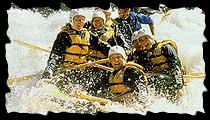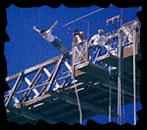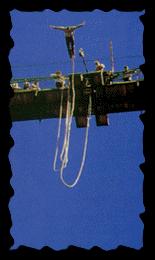Queenstown, New Zealand
Located in Central Otago in a lakeside bay, Queenstown is New Zealand's premier alpine resort. Rich in history, and abundance of recreations and a breathtaking natural beauty that lends each season its own distinct complexion, Queenstown has long been the inspiration for artists and nature-lovers from all over the world eager to capture its dramatic beauty.
Queenstown's fascinating history was founded upon the quest for gold. First settled in 1860, and declared to be "fit for a Queen", the Queenstown district immediately lured prospectors from all corners of the globe. They came to pan the Shotover (the second richest gold-bearing river in the world) and the Arrow Rivers. When the Gold Rush fizzled out, the population quickly dwindled, although their historical legacy persists to this day. A day trip to historic Arrowtown, a stroll amongst the old gold digs and the restored Chinese mining village, reveals a fascinating glimpse into the Gold Rush days.
Built on Queenstown’s foreshore, the Steamer Wharf Village comprises many local and international boutiques and restaurants. It is also the home of TSS Earnslaw, the much loved “Lady of the Lake” and is the active center of social programs and local events.
Adventure Tourism
Queenstown's first real taste of Adventure Tourism came in 1970 with the establishment of commercial jet boating. The jet boat, a New Zealand invention, had been developed by a South Island high country farmer by the name of Bill Hamilton who had long been prevented from accessing many areas of his property due to the shallow rivers. The extensive maneuverability of the boat and its ability to travel in less than 3cm of water allowed for obvious commercial applications to be developed in a place like Queenstown and before long Shotover Jet had established a thrilling ride taking visitors through the spectacular canyons on the Shotover River.
White Water Rafting was to follow quickly on the heels of the success of jet boating. The two nearby rivers the Shotover and the Kawarau were ideal for giving visitors a taste of the thrills and spills of this new activity and it wasn't long before new operators were scrambling to keep up with the demand.
But it was in 1988 with the arrival in town of two entrepreneurs by the name of AJ Hackett and Henry Van Asch that Queenstown was forever to be branded as the 'world's Adventure Capital'. The pair had spent two years working with the University of Auckland developing a special cord made up entirely of individual rubber strands which, when attached to the ankles, could be used to bungee jump from a fixed platform. They originally got the idea from watching native tribes in Papua New Guinea who used forest vines to leap from man made towers, often with tragic consequences.
AJ had some months before received world wide publicity with his daring jump in the early hours of the morning from the Eiffel Tower in Paris. Now, their plan was to use the historic Kawarau Bridge (43m above the river) on the outskirts of Queenstown as the location for the world's first ever commercial bungee jumping site. Many locals were skeptical of the venture, believing that the activity would last only a few months before folding. However, it wasn't long before visitors were flocking to Queenstown in their thousands to experience this newest of adventure activities which everyone was talking about ... and so the bungee phenomenon was born! A year later the company developed a second site at the Skippers Bridge (87m above river level) to keep up with demand for the product followed by the opening of a third site 'The Ledge' at the top of Bobs Peak in 1997. It is estimated that more than 350,000 visitors have bungee jumped in Queenstown since that first commercial jump in 1988.
For approximately two years AJ Hackett operated heli bungee in Queenstown offering visitors the chance to jump from a helicopter hovering more than 450m above the ground. Unfortunately, the license to operate this product was subsequently revoked by the New Zealand Civil Aviation Department following a change in their policy regarding such activities. It is hoped to re-establish, what was a very popular product, in the future.
The wave of interest in bungee jumping was to create an environment for a host of other activity
operators to follow in the wake of the bungee phenomenon and cash in on this new wave of what had been dubbed 'adventure tourism'. Tandem Parapenting was another activity to be pioneered in Queenstown by the late Bruce Grant. This involved attaching the passenger to the 'pilot' with them running off the edge of a mountain side with the wing (canopy) of the parapente rising above to create a sensation almost like a bird gliding to earth. [Bruce was later to be tragically killed in 1995 while climbing K2 in Pakistan]
Tandem skydiving, tandem hang gliding, river surfing, parasailing, canyoning, abseiling were all to follow including the establishment of a second bungee site in 1994 at Skippers Canyon, operated by Pipeline Bungee. This new site at 102m was to eclipse the Skippers site operated by AJ Hackett making it, at the time, the highest commercial jump in New Zealand.
In July 1999, AJ Hackett opened its newest site 'The Nevis' located at Nevis Bluff, close to its existing Kawarau Bridge operation. This latest venture will involve visitors jumping from a platform suspended from overhead cables and positioned more than 135m above the river below making this now the highest commercial bungee jump from a fixed structure in New Zealand.
Queenstown will continue to find ways to challenge the adventurous. Its a place inextricably linked to adventure tourism ... a place that has well and truly earned its reputation as the world's Adventure Capital!


